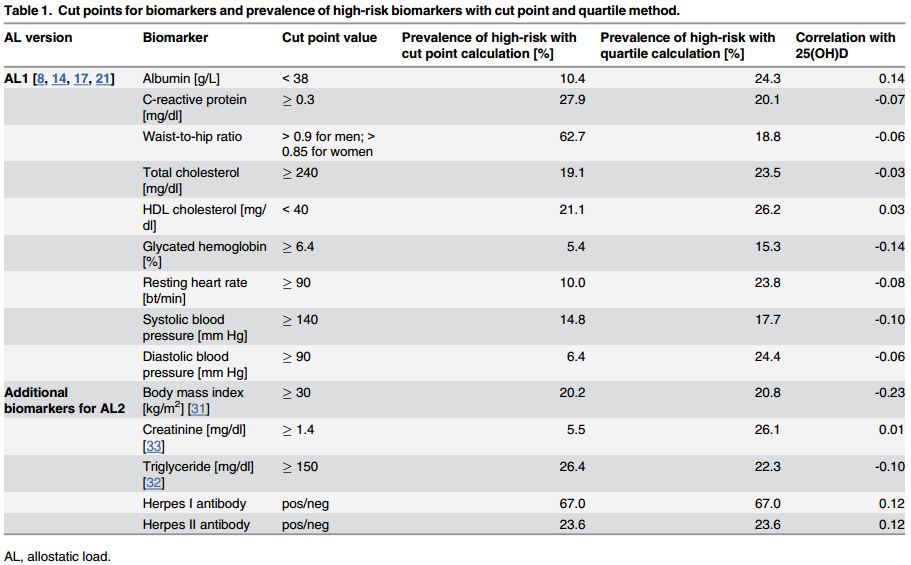More stress (allostatic load biomarkers) associated with vitamin D deficiency
Relationship of Serum Vitamin D Concentrations and Allostatic Load as a Measure of Cumulative Biological Risk among the US Population: A Cross-Sectional Study.
PLoS One. 2015 Oct 9;10(10):e0139217. doi: 10.1371/journal.pone.0139217.
Frei R1, Haile SR1, Mutsch M1, Rohrmann S1.
1Division of Chronic Disease Epidemiology, Epidemiology, Biostatistics and Prevention Institute (EBPI), University of Zurich, Zurich, Switzerland.
INTRODUCTION: The allostatic load (AL) index is a multi-systemic measure of physiologic dysregulation known to be associated with chronic exposure to stress and adverse health outcomes. We examined the relationship between AL and serum 25-hydroxyvitamin D (25(OH)D) concentration in non-institutionalized US adults.
METHODS: Data from the Third National Health and Nutrition Examination Survey (NHANES III, 1988-94) were used to calculate two versions of AL including 9 biomarkers and another two with 14 biomarkers (systolic and diastolic blood pressure, pulse rate, serum cholesterol, serum HDL-cholesterol, glycated hemoglobin, sex-specific waist-to-hip ratio, serum albumin, and serum C-reactive protein for AL1, and, additionally body mass index, serum triglyceride, serum creatinine, and serum herpes I & II antibodies for AL2), each set defined by predefined cut-offs or by quartiles. Serum vitamin D concentration was ranked into quartiles. Logistic regression, Poisson regression and linear regression were used to examine the association of serum 25(OH)D concentrations on AL, after adjusting for biological, physiological, socioeconomic, lifestyle, and health variables.
RESULTS: Odds Ratios (OR) for high AL of the lowest 25(OH)D serum quartile were between 1.45 (95% CI: 1.28, 1.67) and 1.79 (95% CI: 1.39, 2.32) for the fully adjusted model, depending on AL version. Inverse relationships between vitamin D serum concentrations were observed for all AL versions and every adjustment. This relationship was consistent after stratification by sex, age or ethnic background.
Sensitivity to low 25(OH)D concentrations was highest among the youngest group (20-39 years) with an OR of 2.11 (95% CI: 1.63, 2.73) for the lowest vitamin D quartile Q1.
CONCLUSIONS: Vitamin D had a consistent and statistically significant inverse association with all tested models of high AL, which remained consistent after adjusting for biological, socioeconomic, lifestyle and health variables. Our study adds evidence linking low 25(OH)D concentrations with poorer health, further-reaching than bone health.
📄 Download the PDF from VitaminDWiki

Clipped from Discussion
Within our sample, the prevalence of a high AL was 13.2% for participants aged 20–39
years, 33.8% for 40–59 year aged and as high as 54.9% for participants older than 60 years. It is
well known that AL increases (non-linearly) with age, which is plausible because AL measures
the cumulative biological risk that increases with age [49]. Sensitivity to low 25(OH)D concentrations
was highest among the youngest group (20–39 years) with an OR of 2.11 (95% CI:
1.63; 2.73) for the lowest vitamin D quartile Q1, but higher 25(OH)D concentrations were
associated with lower OR for high AL within all age categories. By including all adult age
groups in the analysis we were able to identify an otherwise neglected at-risk group, those aged
20–39 years.
Conclusions (from PDF)
Allostatic load is a powerful tool to assess the harmful effects of chronic stress to the human
body on a multisystem level. There is an urgent need of agreement on the method and the biomarkers
to calculate the AL index. Vitamin D has a statistically significant inverse association
with all tested models of high AL, which was persistent after adjusting for biological, socioeconomic,
lifestyle and health variables. Our study adds to the increasing evidence linking low
vitamin D serum concentrations to adverse health outcomes, beyond its role in bone health.
Prospective studies need to address the question whether low 25(OH)D concentrations are the
cause or the outcome of high AL. If vitamin D supplementation can be shown to lower AL,
vitamin D could become a relevant preventive measure to reduce the harmful effects of chronic
stress in humans.
Comment by Henry Lahore of VitaminDWiki
It seems unlikely that low vitamin D ==>high allostatic load index
Seems more likely that high allostatic load index ==> low vitamin D
Increased vitamin D "might" prevent stress and "might" reduce stress,
BUT restoring vitamin D levels should most certainly reduce other health problems assocaiaed with low vitamin D
see Diseases that may be related via low vitamin D
